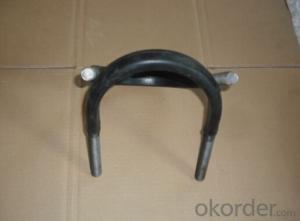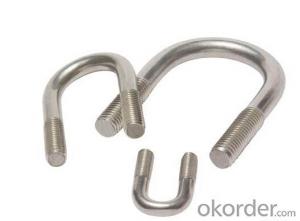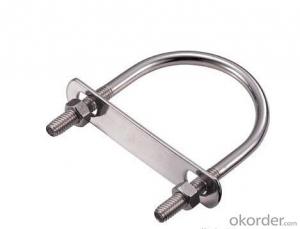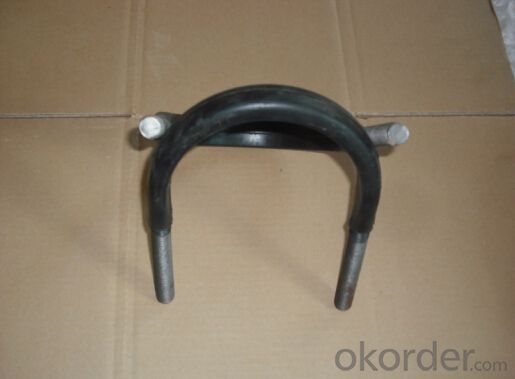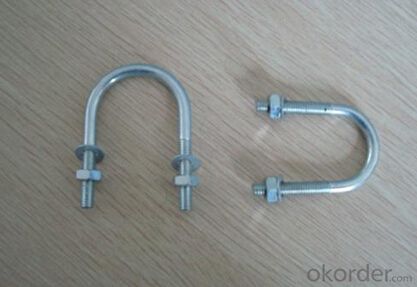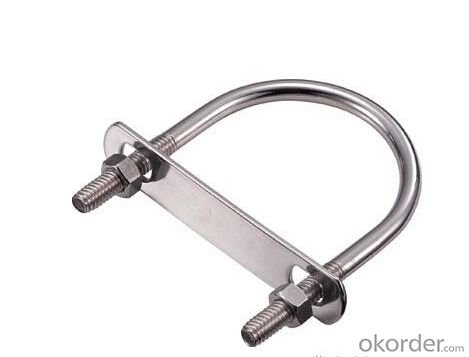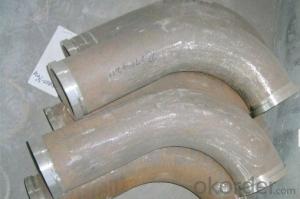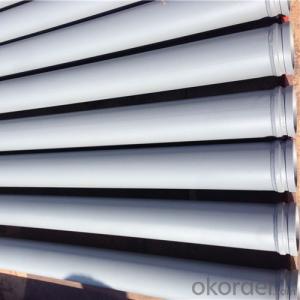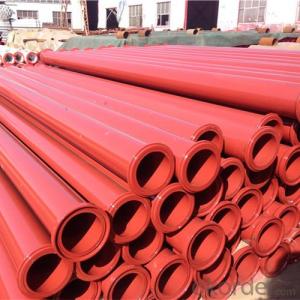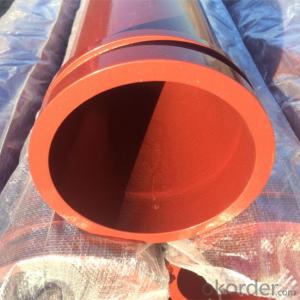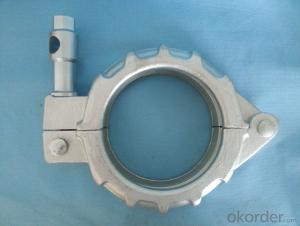U shape pipe clamp for SANY Concrete Pump with high quanlity
- Loading Port:
- Shanghai
- Payment Terms:
- TT OR LC
- Min Order Qty:
- 1 set
- Supply Capability:
- 1000 set/month
OKorder Service Pledge
OKorder Financial Service
You Might Also Like
Concrete pump pipe clamp is applicable to concrete pump pipe.Its belongs to concrete pump spare parts
U shape pipe clamp for SANY Concrete Pump with high quanlity
Specifications
stainless steel u bolt clamp steel pipe
1.Manufactur supply directly.
2.Size:M4-M48.etc
3.ISO,SGS.
4.Grade:201,304,316...
stainless steel u bolt clamp steel pipe
Size:stainless steel u-bolts
M6x16-50
M8x20-100
M10x20-100
M12x20-100
M14x30-100
M16x30-100
M18x40-100
M20x40-100
M22x50-100
M27x50-100
M30x50-100
M36x50-100
material:stainless steel
201
304 0Cr18Ni9 304L 00Cr19Ni10
321 0Cr18Ni9Ti 316 0Cr17Ni12Mo2
316L 00Cr17Ni14Mo2 310S 0Cr25Ni20
surface:bright
Tolerance: +/-0.015mm
Grade: 4.6 4.8 5.6 5.8 6.8,etc
DN125 Concrete Pump Clamp Coupling
Type-HD
| 1.5" clamp HD |
2" clamp HD |
| 3" clamp HD |
| 4" clamp HD |
| 3"clamp HD (adjustable) |
| 4"clamp HD (adjustable) |
| 2.5" clamp HD |
| 5" clamp HD |
| 5" clamp HD (adjustable) |
Type-Bolt& snap
Bolt Clamp 2" |
| Bolt Clamp 3" |
| Bolt Clamp 4" |
| Bolt Clamp 5" |
| Bolt Clamp 6" |
| Bolt Clamp Boom Bracket Type 5" |
| Two Bolts Boom Clamp 5" |
| Snap Clamp 2" |
| Snap Clamp 3" |
| Snap Clamp 4" |
| Snap Clamp 4.5" |
| Snap Clamp 5" |
| Snap Clamp 6" |
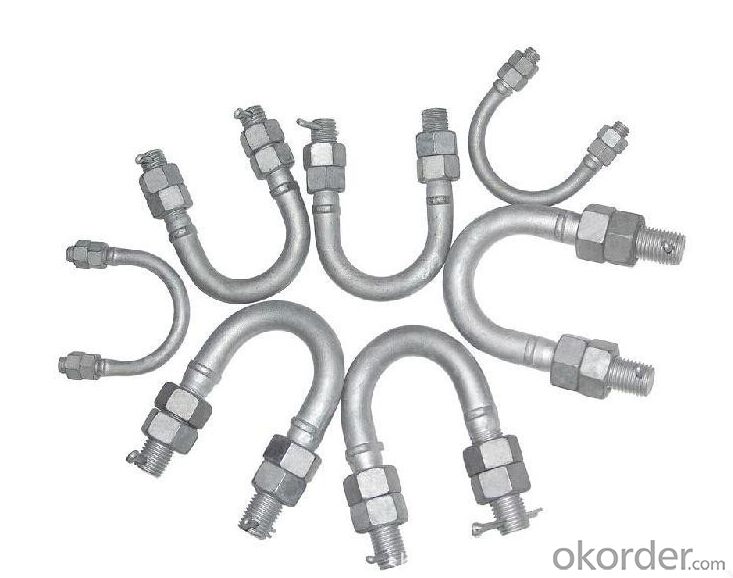
- Q: Are there any specific guidelines for the installation of seal kits or O-rings in concrete pump spare parts?
- Yes, there are specific guidelines for the installation of seal kits or O-rings in concrete pump spare parts. Here are some general guidelines to follow: 1. Safety precautions: Always ensure that the concrete pump is turned off and depressurized before attempting to install any seal kits or O-rings. Wear appropriate safety gear, such as gloves and goggles, to protect yourself during the installation process. 2. Preparation: Thoroughly clean the area where the seal kits or O-rings will be installed. Remove any debris or old seal remnants to ensure a clean and smooth surface for installation. 3. Inspection: Before installing new seal kits or O-rings, inspect them for any defects or damage. If any issues are found, replace the faulty parts with new ones. 4. Lubrication: Apply a small amount of compatible lubricant or hydraulic oil to the seal kits or O-rings to aid in their installation and prevent damage during the process. Be sure to use a lubricant that is compatible with the materials used in the seal kits or O-rings. 5. Proper alignment: Carefully align the seal kits or O-rings with their respective grooves or seating areas in the concrete pump. Ensure that they are properly seated and positioned before proceeding. 6. Correct installation technique: Use the appropriate tools and techniques to install the seal kits or O-rings. Avoid excessive force or bending, as this can lead to damage or improper sealing. 7. Testing: After the installation is complete, test the concrete pump to ensure that the seal kits or O-rings are functioning properly. Check for any leaks or abnormal behavior during operation. 8. Regular maintenance: Once the seal kits or O-rings are installed, it is important to regularly inspect and maintain them to ensure their longevity and optimal performance. Follow the manufacturer's recommended maintenance schedule and guidelines for best results. It is important to note that these guidelines are general in nature and may vary depending on the specific make and model of the concrete pump. Therefore, it is always recommended to consult the manufacturer's instructions and guidelines for the particular seal kits or O-rings being installed.
- Q: How do I find the right part number for a specific concrete pump spare part?
- To find the right part number for a specific concrete pump spare part, there are a few steps you can follow: 1. Identify the specific part you need: First, determine the exact part you are looking for. This could be a specific component or a replacement part for a particular area of the concrete pump. 2. Consult the equipment manual: Check the equipment manual or documentation that came with the concrete pump. The manual often includes a parts list or diagram, which can help you identify the part number you need. 3. Contact the manufacturer or supplier: Reach out to the manufacturer or supplier of the concrete pump to inquire about the specific part you require. Provide them with the make, model, and serial number of the pump, as well as a detailed description or photograph of the part if possible. They should be able to provide you with the correct part number and any additional information you may need. 4. Use online resources: Utilize online resources such as manufacturer websites, spare parts catalogs, or specialized equipment platforms. These platforms often have search functions where you can input the make and model of the concrete pump to find the corresponding part numbers. 5. Seek assistance from industry experts: If you are still unable to find the right part number, consider reaching out to industry experts or professionals who specialize in concrete pump equipment. They may have the knowledge and experience to help you identify the correct part number based on your specific needs. Remember to double-check the part number provided by the manufacturer or supplier to ensure accuracy before making any purchases. Additionally, it is advisable to keep a record of the part number for future reference in case you need to reorder or replace the part again.
- Q: How often should concrete pump seals be replaced?
- The replacement of concrete pump seals depends on various factors, such as the type of pump, seal quality, operating conditions, and maintenance practices. It is generally recommended to inspect and replace the seals every 500 to 1,000 pumping hours or annually, whichever comes first. It is crucial to regularly inspect the seals to detect any signs of wear or damage. Common indications for replacement include leaks, excessive vibration, reduced pumping efficiency, or visible degradation of the seal material. If any of these issues are observed, it is important to promptly replace the seals to prevent further damage and ensure optimal pump functioning. It is important to note that certain pumps may require more frequent seal replacements due to their design or operating conditions. For example, high-pressure pumps or those used in abrasive environments may experience accelerated seal wear, necessitating more frequent replacements. To extend the lifespan of concrete pump seals, proper maintenance and care are essential. This involves regularly cleaning the pump and seals, ensuring proper lubrication, and following the manufacturer's guidelines for operation and maintenance. Additionally, using high-quality seals and regularly inspecting them for wear can help prolong their longevity. Ultimately, determining the replacement frequency of concrete pump seals involves a combination of regular inspections, adherence to maintenance practices, and consideration of specific operating conditions.
- Q: What are the indications of a faulty concrete pump hydraulic motor?
- Some indications of a faulty concrete pump hydraulic motor may include decreased pumping efficiency, irregular or inconsistent flow of concrete, unusual noises or vibrations, leaks or drips in the hydraulic system, excessive heat in the motor, or difficulty in starting or stopping the motor.
- Q: Are there any specific guidelines for the installation of control panels or electronic components in concrete pump spare parts?
- Specific guidelines exist for the installation of control panels or electronic components in concrete pump spare parts. When installing such components, it is important to consider the following guidelines: 1. Protection from Moisture: Electronic components can be damaged by moisture, so it is advisable to install them in waterproof or moisture-resistant enclosures to prevent damage from water or humidity. 2. Vibration and Shock Absorption: To avoid damage, it is recommended to use shock-absorbing mounts or vibration-resistant enclosures to minimize the impact of vibration and shock on control panels or electronic components. 3. Temperature Control: Extreme temperatures can affect concrete pump spare parts, so it is crucial to install control panels or electronic components in a temperature-controlled environment. This may involve using insulation or cooling systems to maintain a suitable operating temperature. 4. Wiring and Connections: Proper wiring and connections are essential for the functioning of control panels or electronic components. It is important to follow the manufacturer's instructions and guidelines for wiring, ensuring secure connections and providing adequate insulation and protection against short circuits or electrical hazards. 5. Accessibility and Maintenance: Control panels or electronic components should be installed in a way that allows easy access for maintenance and repairs. Sufficient space should be left around the components for easy inspection, servicing, and replacement if needed. By adhering to these guidelines, the installation of control panels or electronic components in concrete pump spare parts can be carried out to ensure their long-term functionality and durability.
- Q: What are the safety measures to consider while replacing concrete pump spare parts?
- To ensure the safety of workers and the successful replacement process of concrete pump spare parts, it is important to consider several safety measures. Firstly, before beginning any maintenance or replacement work, it is crucial to adhere to proper lockout/tagout procedures. This involves disconnecting the equipment from its power source and using lockout devices to prevent accidental startup. This ensures that the equipment cannot be operated while replacement work is being carried out. Secondly, workers involved in the replacement process should wear the appropriate personal protective equipment (PPE). This includes safety goggles, gloves, hard hats, and steel-toed boots to protect against potential hazards such as flying debris, falling objects, or accidental contact with sharp edges. Additionally, prior to starting the replacement, a thorough inspection of the equipment should be conducted to identify any potential hazards or defects. This includes checking for damaged or worn-out parts, loose connections, or any signs of deterioration. If any issues are found, they should be resolved or repaired before proceeding with the replacement. Furthermore, proper lifting techniques must be utilized to prevent musculoskeletal injuries. Concrete pump spare parts can be heavy and bulky, so workers should be trained on lifting techniques and should use mechanical aids like cranes, hoists, or forklifts when necessary. When dealing with heavy or awkwardly shaped parts, team lifting should be employed. Moreover, the work area should be secured to prevent unauthorized access and ensure the safety of workers. This can be done by using barricades or caution tape to cordon off the area and provide warnings to others about the ongoing replacement work. Adequate lighting should also be provided for clear visibility. Using the right tools and equipment is crucial for safe and efficient replacement work. Workers should be trained on the proper use of tools and ensure that they are in good working condition. Using damaged or faulty tools can lead to accidents or improper installation of the spare parts. Lastly, it is important to follow the manufacturer's instructions and guidelines for replacing concrete pump spare parts. This includes understanding the correct sequence of steps, torque requirements, and any special precautions that need to be taken. Deviating from the manufacturer's instructions can compromise the safety and performance of the equipment. By implementing these safety measures, the risk of accidents, injuries, or equipment damage can be minimized during the replacement of concrete pump spare parts. Safety should always be prioritized, and all workers involved should be properly trained and equipped to carry out the replacement work.
- Q: How long do rubber pistons typically last in a concrete pump?
- Rubber pistons in a concrete pump typically last for several thousand pumping hours before they need to be replaced. However, the lifespan can vary depending on factors such as the quality of the rubber, the intensity of use, and the maintenance practices followed.
- Q: Do concrete pump spare parts come with a warranty?
- Yes, concrete pump spare parts do come with a warranty. The warranty period may vary depending on the manufacturer and the specific part being purchased. Generally, reputable manufacturers and suppliers offer warranties on their spare parts to provide assurance to customers about the quality and reliability of the product. It is important to carefully review the terms and conditions of the warranty to understand what is covered and for how long. If any defects or issues arise during the warranty period, customers can typically get a replacement or have the part repaired at no additional cost.
- Q: How to choose concrete pump?
- In order to ensure that the concrete pump has a larger amount of transportation, but also has a certain outlet pressure and the corresponding economic power, in the design of concrete pump, most of the constant power piston pump is used
- Q: What is the function of a concrete pump remote control antenna?
- The primary role of a concrete pump remote control antenna is to establish a wireless connection between the remote control device and the concrete pump. This connection enables the operator to remotely manage various functions of the concrete pump, including initiating and terminating the pump, adjusting concrete speed and flow, and controlling boom movements. The antenna receives signals transmitted by the remote control device and transmits them to the concrete pump, enabling the operator to safely control the pump from a distance. By providing the operator with improved visibility of the pump and its surroundings, while maintaining complete operational control, this technology contributes to enhanced efficiency, accuracy, and safety at construction sites.
Send your message to us
U shape pipe clamp for SANY Concrete Pump with high quanlity
- Loading Port:
- Shanghai
- Payment Terms:
- TT OR LC
- Min Order Qty:
- 1 set
- Supply Capability:
- 1000 set/month
OKorder Service Pledge
OKorder Financial Service
Similar products
Hot products
Hot Searches
Related keywords
